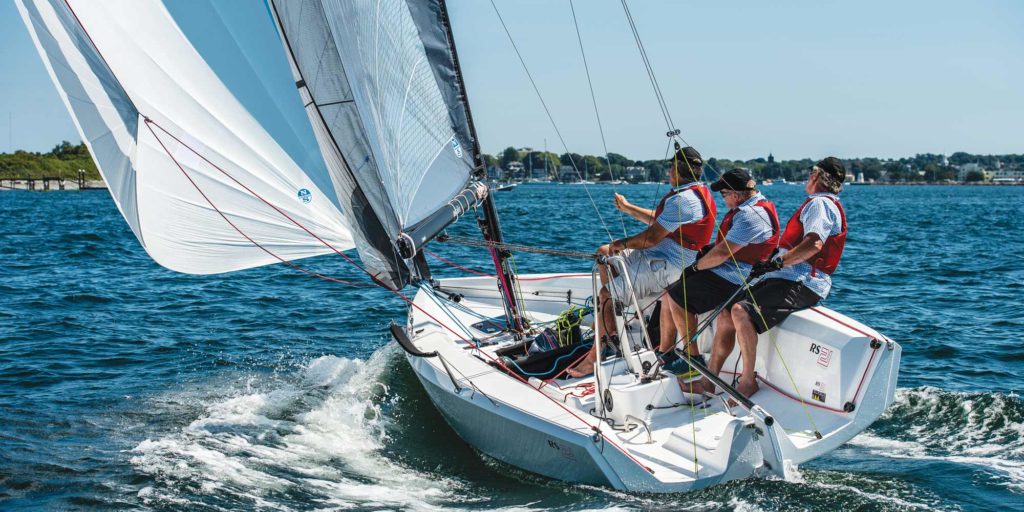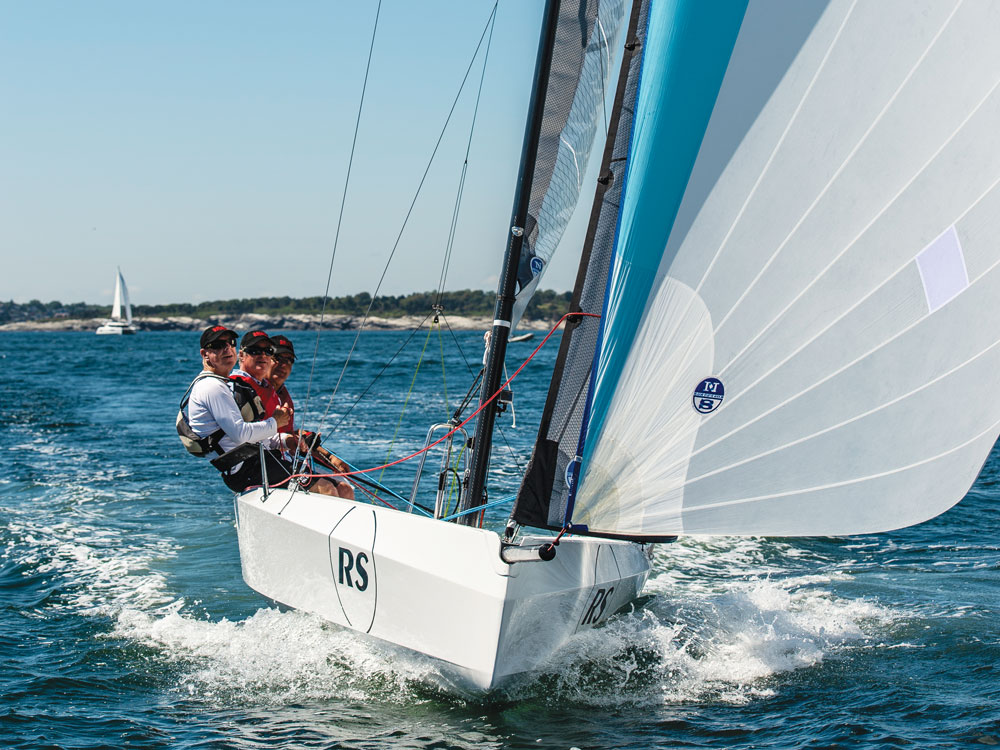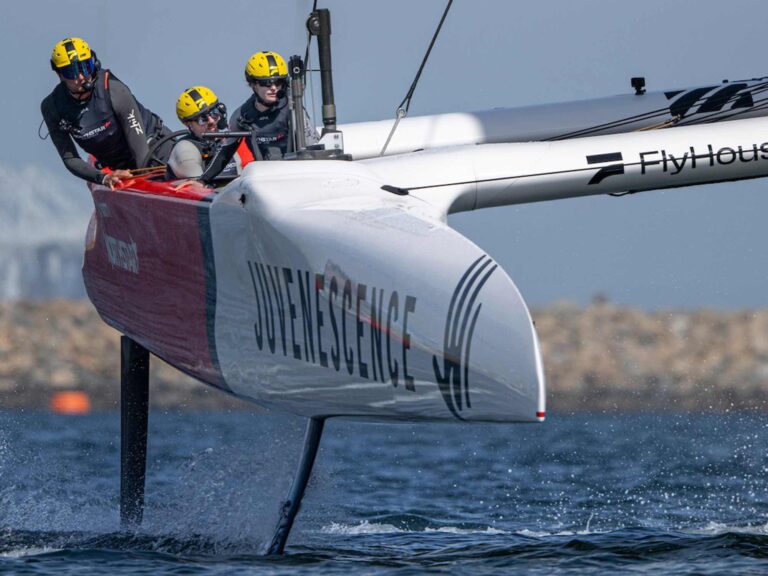
A s finely crafted, enjoyable to sail and otherwise perfect as the RS21 may be, there is one problem. For it to become the next popular keelboat, yacht clubs and sailors beholden to ancient local fleets must step up and embrace change. Today, there is a better boat to set the hook deeper into these sailors, and that boat is the RS21. This a club racer first. A one-design second.
While the RS21 is a high-tolerance one-design keelboat, its list of potential uses is long. It’s ideal for athletic match racers and team racers. It’s a weeknight beer-can racing machine that comes from the factory fitted with all the hardware necessary to switch between asymmetric and symmetric spinnakers. RS Sailing promotes this 21-footer as a “team boat,” meaning everyone can and will be involved in the sailing, and they’re right.
There’s elbow room for a crew of four or five, and the right amount of strings to pull. Jib-tack height is adjustable during setup, using a purchase system that’s covered by a Velcro flap to prevent the spinnaker from snagging the forestay turnbuckle. The jib has hanks, and with the cutout foredeck, a less-than-nimble bowperson can easily go forward without fear of falling overboard.
There’s a large recessed hatch, and when it’s open, one can behold the beauty of the boat’s cored vinylester laminate. The core material is recycled plastic that provides a noticeable amount of panel stiffness for its weight. It’s not an excessively thick laminate, Tom Rich says, but it’s solid to the tap test. Should the boat be totaled in an unforeseen disaster, it can be ground to bits and reused as material for the next boat. A Torqeedo battery is accessible through the foredeck hatch, and there’s room to store rolled sails inside. There’s even a pre-installed through-deck fitting for wiring mast-mounted electronics.
The Selden carbon rig (aluminum boom) is easy to tune from the turnbuckles, between races, as with other keelboats. Both the jib and main halyard exit from the mast and hook into fine-tune purchase systems, which allows draft adjustments on the fly and eliminates struggles common to horn cleats. The cunningham and vang are not led outboard, but each is reachable from the legs-in hike position. Jib leads are 2-to-1, with adjustment stops on short transverse tracks. All-in-all, the judges say the RS21’s simple front-of-the-boat layout won’t intimidate inexperienced crews, but the ability to easily play with sail shape will appeal to more advanced tweakers.
The judges also agreed on one thing after several hours of sailing in midrange wind conditions: The boat is not dumbed down or too difficult. It will reward acute awareness of weight placement, an understanding of what mode is best for the moment and, of course, smooth boathandling. “The balance of the helm is really nice,” Greg Stewart says. “It never wants to wipe out, and the [North] sails are good. It’s built well, and I would recommend it to anyone. I’m scratching my head to come up with anything wrong with it.”

For efficient boathandling, control lines and sheet angles are good, and the center pod is an unexpected asset. Critics will pan the fiberglass structure and its “granny bar” as ugly, but it does serve purposes, primarily to house the Torqeedo electric outboard when it’s stowed and raised (when stowed, a fiberglass panel door lies flush to the hull). The pod also allows the RS21 to use a split mainsheet so one crewmember can take over from the helmsman. The stainless-steel grab provides an excellent balance point for the helmsman when crossing the boat, which senior club members will appreciate. The youngins’, no doubt, will use it to put extra energy into every roll tack.
Cockpit ergonomics are excellent for a boat this size. There’s comfortable upright sitting against lifelines, with beveled corners in the deck. “It’s got the low freeboard, the reverse bow, the chamfers forward and the chine back aft, so it definitely has the look of a modern boat,” Stewart says. “It’s amazing how stable it is. When we put four guys on one side deck and tried to heel it at the dock it barely moved. I felt that same stability when sailing. It feels like a big boat more than it does a dinghy.”
Allen agrees, adding, “I liked it a lot. All the adjustments and everything were handy at the mast, and the backstay and everything else were nicely led.”
“Upwind, when the crew weight is in the right spot, it makes a huge difference on the load on the helm,” Allen says. It’s like a Viper in that it has the same feel. But with the RS21, if you’re racing it, you want to be dead flat or have a bit of weather heel. It has a fine groove, and when you’re in it, you know it. Downwind sailing is easy with this thing when the leech-twist profiles match.”
Sailing it may be easy, but the true challenge, Rich says, will be selling a $40,000 boat to yacht clubs. “It’s a problem with the demographics of the clubs themselves,” he says. “The members who can afford these boats are older, perhaps too old for these types of boats. Is it too sporty or too wet for the 60-year-old member?”
Perhaps, but it’s right on target for next-generation members groomed in performance boats, so it’s a question of whether senior members are willing to invest in the future of their club fleet by giving younger members a reason to belong, beyond the bar, the ballroom or the pool.









